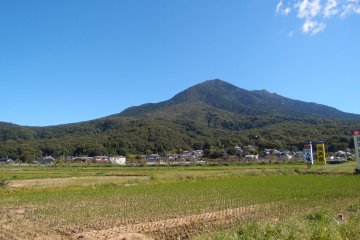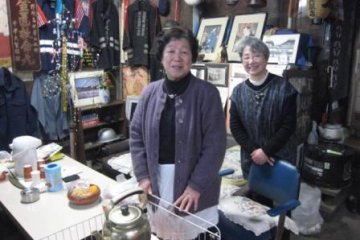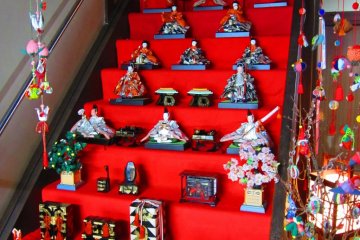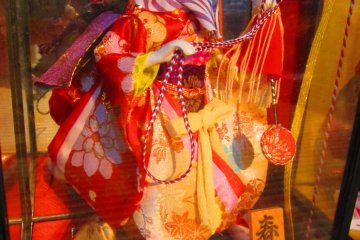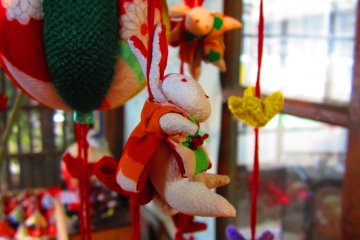Walking through the streets of Makabe is a little like hopping through time. But it is not only the architecture that inspires such a warm, nostalgic air, it is the community itself. Especially during the highly-valued local Hina Festival, homes and hearths are opened to the public and the town lights up with the glow of generosity and geniality.
Within Ibaraki, Makabe is known as the ‘stone town’; the proximity of high-quality stone in the surrounding mountains led to a thriving industry of stone-cutters and sculptors, and the outer reaches of the town are littered with monuments, gravestones, statues, and rough-hewn rocks of all shapes and sizes. However, in contrast to this economic ‘stone culture’, the town itself is populated with beautifully aged wooden homes, most over a hundred years old. With elegantly sloping, thick-tiled roofs, intricate lattice-work and charmingly simplistic styling, each home or store has its own special allure and a walk through town just to visually feast on the wealth of wabi/sabi would be a treat in and of itself.
The Hina Festival is a well-loved tradition held all over Japan, with the main celebration designated for March 3rd. Ostensibly it evolved as a feting of female children in the household, usually involving putting the girl’s hina dolls on display, having the girl dress up, and, of course, special gourmet treats. Hina dolls themselves originate in the Heian era of Japanese history, purportedly as a way of teaching girls how to keep house and become a good wife. They usually came in sets complete with a husband and wife, some servants, and many small accoutrements like lamps, utensils, furniture, musical instruments, and much more. In a sense, it was a similar concept to the Western dollhouse (and in the Heian period there were even houses for the dolls to play in) and game of ‘playing house’.
As the years went on the dolls became less for actual play and more for simple display. If a girl child was born, a hina doll set was a must. Though originally made of paper, the dolls became more and more elaborate; bodies made of cloth, wood, or porcelain became standard, and most dolls had fully-featured faces and outfits. Many female dolls came with the requisite 12-layer kimono, made of real silk and hand-stitched, and the little accoutrements, like lamps that light up, grew ever more realistic. In a real sense, these former tools of socialization became a form of cultural art, one that is still widely celebrated today.
And, sure enough, in searching their storehouses and backrooms, the citizens of Makabe uncovered an entire museum’s worth of vintage hina dolls. Some dating from as far back as the Edo period (hundreds of years ago), these childhood relics are remarkably well preserved, most without a missing finger or hair. Thus was born the Makabe Hina Festival, currently celebrating its 10th anniversary.
Though in the beginning only 20-odd families chose to display their dolls to the public, currently there are 160 different locations that have opened their doors to visitors. Bringing in roughly one hundred thousand tourists in the one month period, the little town has grown in renown in a very short period of time. There are maps and suggested routes, but most streets have multiple homes or businesses with their beautifully varied dolls on view on the traditional bright-red carpeted staircase dais. But not only are you invited to have a look up close, the proud owners have instituted a custom of hospitality that includes feeding their guests and sitting down for a chat.
At each location we visited we were warmly welcomed and invited in, given short explanations of the origins of the dolls or their owners, and often treated to food or drink. From the slightly sweet warmth of amazake (a drink made from lightly cultured rice-water) to the heart-warming tales of visitors from as far as Osaka gifting their own dolls so they could be displayed in Makabe, the generosity and sincerity of the residents makes one feel at home almost instantly.
Besides the dolls, local artisans also have their wares on display, including beautifully intricate hand-stitched quilts based on famous paintings and made of old kimonos, and pressed-flower pictures that one would swear were painted with brush and ink until one looks closely enough to see the veins of the leaves and petals comprising them. There are even special events, such as Japanese traditional puppet-shows using hina dolls, and even a hina doll wedding ceremony (Feb. 25th).
For the duration of the festival, February 2nd to March 3rd, there are special buses running from both Tsukuba and Iwase stations directly to Makabe every hour, meaning it is accessible via both the Joban and Mito lines, and several free parking areas are available for those coming by car. Though a visit any time would be worth the effort for the beautiful buildings, this festival provides a chance to interact with and enjoy the ambiance of the tightly-knit community, through the medium of these gorgeously crafted dolls.





